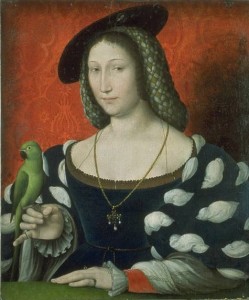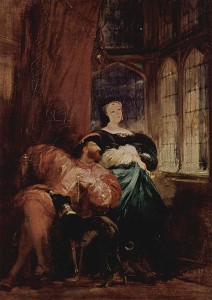“In Marguerite the Renaissance and the Reformation were for a moment one. Her influence radiated throughout France. Every free spirit looked upon her as protectoress and ideal …. Marguerite was the embodiment of charity. She would walk unescorted in the streets of Navarre, allowing any one to approach her and would listen at first hand to the sorrows of the people. She called herself ‘The Prime Minister of the Poor’. Henri, her husband, King of Navarre, believed in what she was doing, even to the extent of setting up a public works system that became a model for France. Together he and Marguerite financed the education of needy students.” Will Durant
On this day in 1549, Marguerite de Navarre (also known as Marguerite of Angoulême and Margaret of Navarre) died aged 57.
Marguerite married Charles IV, Duke of Alencon in 1509 and after his death became the Queen Consort of Henry II of Navarre. Her brother became King of France, Francis I in 1515.
Some historians have interpreted Anne Boleyn’s service at the French court to mean that she must have been close, not only to Queen Claude whom Anne served for 6-7 years (the wife of King Francis I) but also to Marguerite d’Angouleme. The fact that Marguerite was a noted supporter of religious reform only served to further cement this assumption.
Eric Ives notes that even ‘careful’ scholars like Herbert of Cherbury ‘took it as a fact that Anne served in the household of the Duchess of Alencon, sister to Francis’ (Pg. 32) although Ives believes this is highly unlikely:
‘When reporting Francis I’s complaint in January 1522 about Anne leaving France, the imperial ambassadors described her quite unequivocally as one of his wife’s ladies, just as she had been in 1515.’ (Pg. 32)
Although it is unlikely that Anne was in service to Marguerite, it is likely that they knew each other.
In June 1519, Thomas Boleyn was Henry VIII’s representative at the christening of Claude’s second child, the future Henry II, Marguerite’s nephew.
Ives believes that Thomas would have taken this opportunity to introduce his daughter to Marguerite. What she thought of her sister-in-law’s lady in waiting is unknown but in 1532, when Marguerite was Queen of Navarre, the English tried to get her to accompany her brother to Calais to meet Henry and Anne, but their efforts were in vain – Francis came alone.
Some historians have concluded that this ‘dismissal’ shows that Marguerite was ‘bitterly hostile to the projected marriage’ (Pg. 32) but there might be another explanation.
It was at around this time that Francis I was trying to negotiate a match between his son Henry and Catherine de Medici – the Pope’s niece… Probably not the best time for it to appear that he was endorsing Anne’s position.
Other indications that Anne favoured Marguerite are:
In 1533, the Duke of Norfolk had two five-hour consultations with her and was convinced that she was ‘as affectionate to your highness as if she were your own sister, and likewise to the queen…My opinion is that she is your good and assured friend.’ (Pg. 33)
In 1534, Anne Boleyn confided to Marguerite that she was expecting a child and so a planned meeting between Henry and Francis had to be postponed, as she could not travel and needed Henry with her at the time of her confinement. Ives suggests that the real reason might have been that Henry feared trouble at home but nevertheless, George Boleyn delivered the message to Marguerite and insisted that Henry was still determined to meet with Francis:
‘Her Grace is now driven to her sheet anchor in this behalf, that is, to the only help of the said Queen of Navarre, and the goodness of the good King her brother, for Her Grace’s sake, and at this Her Graces’ suit and contemplation, to stay the King’s Highness her husband, and to prorogue their interview till a more commodious and convenient time for all parties.’ (Pg. 33)
In 1534, Anne had assured Marguerite that although at the 1532 meeting there had been ‘everything proceeding between both kings to the queen’s grace’s singular comfort, there was no one thing which her grace so much desired…as the want of the said queen of Navarre’s company, with whom to have conference, for more causes than were meet to be expressed, her grace is most desirous.’ (Pg. 33)
A message from Anne to Marguerite in 1535 stated ‘that her greatest wish, next to having a son, was to see you again’ (Pg. 33).
Are these remarks evidence of a close friendship between Anne and Marguerite? Or, as Ives suggests, could these remarks be Anne’s attempts to turn ‘mere acquaintance into a bosom friendship’ (Pg. 33).
Ives also points out that many of the books that Anne collected during her time as Queen, came from authors and printers that had been ‘encouraged by the Queen of Navarre.’ Ives even speculates that Anne would have possessed a copy of Marguerite’s Le Miroir de l’aime pecheresse, published in 1531, and claims that this exact copy might have been the one her daughter Elizabeth would use in 1545, when translating this work for her step-mother, Katherine Parr (Pg. 278).
Ives believes that there are also parallels between ‘Anne expressing her faith in fine illuminated manuscripts and Marguerite doing the same’ (Pg. 278).
It seems likely then that Anne saw Marguerite as a role-model, although Ives does not agree with earlier writers whom assumed that Marguerite was responsible for Anne’s interest in French reform (Pg. 277).
The true nature of Marguerite’s feelings towards Anne and the extent of their ‘friendship’ remains a mystery but what the evidence suggests is that during Anne’s reign Marguerite was ‘favourable to England, and to Anne.’
Jules Michelet wrote of Marguerite, “Let us always remember this tender Queen of Navarre, in whose arms our people, fleeing from prison or the pyre, found safety, honor, and friendship. Our gratitude to you, Mother of our [French] Renaissance! Your hearth was that of our saints, your heart the nest of our freedom.”
References
Ives, E. The Life and Death of Anne Boleyn, 2004.



















Thanks a lot for your very interesting blog about Anne Boleyn and Marguerite de Navarre.
I have been fond of books about her for long time.
The latest one I have read is sold on Amazon. The ebook is entitled “Anne Boleyn’s Secret Love at the Court of Francis I”. It is translated from French into English by Alice Warwick from a book written in the XIXth century.
In a few letters written by Anne Boleyn to her convent friend Anne Savage, you will learn about her early life as a maid of honour to Princess Mary Tudor then to Queen Claude.
The portrait of young and witty Anne Boleyn is passionate. I hope you will enjoy reading about her complete training in music and in the art of conversation at the sumptuous Court of King Francis I.
http://www.amazon.com/Anne-Boleyns-Secret-Court-Francis-ebook/dp/B00JCJAM4O/ref=sr_1_1?s=digital-text&ie=UTF8&qid=1396175818&sr=1-1
Elizabeth I translated the “Miroir” and her manuscript of that translation is on view at the Morgan Library and Museum in the Treasures of the Bodlien exhibit which will be on view until at least Sept. 12.